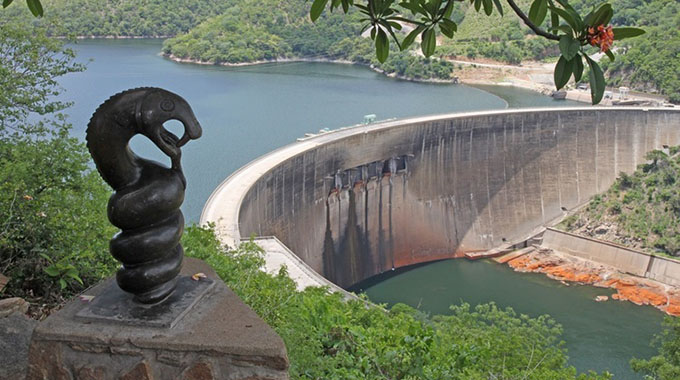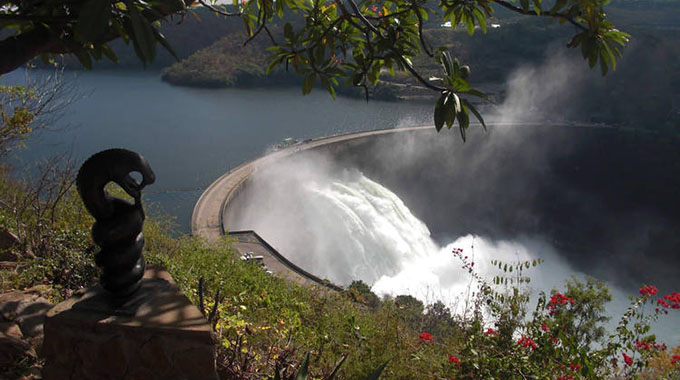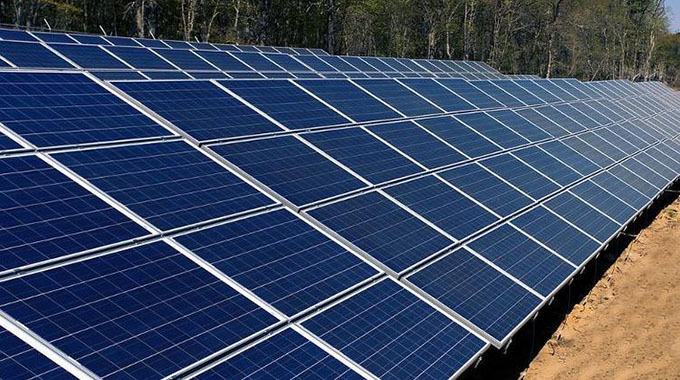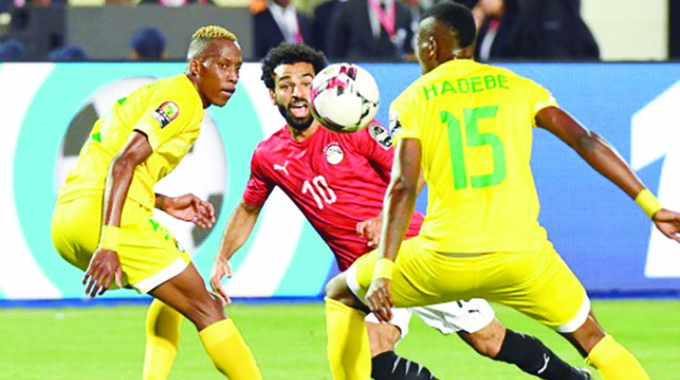Myth, tale of Kariba’s Nyaminyami

Isdore Guvamombe Assistant Editor
Kariba Dam — Zimbabwe and Zambia’s main source of electricity — has dwindled to a mere 30 percent, sparking myth and mystery, reality and perceptions of reality, science and tradition.
Science or tradition, the agreed fact is that Kariba will not get any significant water inflows between now and April next year, for the Barotse Plains, the source of the mighty river, only rains between March and June.
In normal times
In the belly of the Kariba Dam wall, turbines turn, turn, turn and cringe — again and again — before spitting electricity that is transmitted through the national grid to various parts of the country.
After escaping the wrath of the cruel turbines in a frothing confusion the Zambezi River water appears a bit fatigued as it disappears into a narrow gorge that looks like an abyss. Where it goes thereafter is a narrative for another day.
Elsewhere on the dam, a well-fed monster of a crocodile snaps to life, startled from its nap. It stampedes through the crunchy undergrowth, crashing into the water and becomes invisible except for a pair of sentry-post eyes that peek menacingly above the surface to monitor outside movement.
As if nothing has happened, a huge bull elephant grazes on the shoreline vegetation, its body half-submerged in water, chewing and munching.
The shoreline vegetation is juxtaposed with a cloak of virgin forest, where dappled bush-buck move in fleet yet silent through the thicket.
Shaggy water buck, buffalo and other grazers invade the shoreline for a sip of the life-saving water, forever, stalked by predators.
Facts
One day while the construction of Kariba Dam was at its peak between 1956 and 1959, heavy rains, typical of the biblical Noah’s times, pounced and the coffer dam upstream was destroyed resulting in many workers being swept downstream towards the main dam wall where they were rammed into the wet concrete.
Among the workers were 11 Italians and many blacks. The chief engineer was in a fix, either to pluck out the bodies or plaster them on the wall for eternity.
He made a very bold, practical, technical and strategic decision to leave the bodies plastered on the wall.
Today, the bodies remain part of the Kariba Dam Wall. A church, St Barbra’s Chapel, was constructed in their memory. The blacks were not named, but the Italians have their names inscribed on the church wall in memory.
History
The name Kariba is thought to be a corruption of the Shona word for a small trap — Kariva. It is believed that when those who wished to construct the dam wall wanted to explain the nature of the project to the local BaTonga people, they emphasised that they wanted to build a small water trap — Kariva. However, the complex pronunciation of the “v” in Kariva saw the Italian constructors produce a sound much like a “b” hence the creation of the word Kariba.
The local BaTonga people believed the Zambezi River upon which the trap would be constructed, was superintended over by a fierce river god, Nyaminyami, and they seemed sure the river autochthon would not approve of the dam construction work and that he would one day strike back and destroy the project.
Prior to the dam construction, the BaTonga people lived in the Zambezi Valley for centuries in peaceful seclusion and with little contact with the outside world.
They were simple folk who built their houses in kraals along the banks of the great river and believed that their god, Nyaminyami, looked after them, supplying them with water and fish and food in abundance, but their idealistic lifestyle was to be blown apart. In the early 1940s, a report was made about the possibility of a hydro-electric scheme to supply power for the growing industry that colonialism had brought to Northern and Southern Rhodesia (now Zambia and Zimbabwe.)
In 1956, construction on the Kariba Dam project started.
Heavy earthmoving equipment roared into the valley and uprooted thousands of 100-year-old trees to build roads and settlements to house the workers who poured into the area to build a dam that would harness the powerful river.
The BaTonga’s peace and solitude was shattered and they were told to leave their homes and move away from the river to avoid the flood that the dam would cause. Reluctantly, they allowed themselves to be resettled higher up the bank, but they believed Nyaminyami would never allow the dam to be built and that eventually, when the project failed, they would move back to their homes.
In 1957, when the dam was well on its way to completion, Nyaminyami struck. The worst floods ever known on the Zambezi washed away much of the partly built dam and the heavy equipment, killing many of the workers.
Some of those killed were white men whose bodies disappeared mysteriously, and after an extensive search failed to find them, BaTonga elders were asked to assist as their tribesmen knew the river better than anyone.
The elders explained Nyaminyami had caused the disaster and in order to appease his wrath a sacrifice should be made. Initially, they were not taken seriously, but in desperation, when relatives of the missing workers were due to arrive from Italy to claim the bodies of their loved ones, the search party agreed in the hope that the tribesmen would know where the bodies were likely to have been washed to.
A black calf was slaughtered and floated on the river. The next morning the calf was gone and the workers’ bodies were in its place.
The disappearance of the calf holds no mystery in the crocodile-infested river, but the reappearance of the workers’ bodies three days after they had disappeared has never been satisfactorily explained.
After the disaster, flow patterns of the river were studied to ascertain whether there was a likelihood of another flood and it was agreed a flood of comparable intensity would only occur once every thousand years.
The very next rainy season, however, brought further floods even worse than the previous year.
Nyaminyami had struck again, destroying the coffer dam, the access bridge and part of the main wall. In the process, 11 Italians were swept away and their bodies plastered on the dam wall. The chief engineer calculated and realised it was more structurally sound to leave the bodies plastered there than remove them. Today, their bodies are part of the dam wall.
The project survived and the great river was eventually controlled. In 1960, the generators were switched on and have been supplying electricity to Zimbabwe and Zambia ever since.

This picture shows the dam from a vantage point when the floodgates are opened.
Current
As you sit in your home watching TV or listening to the radio and switching electric gadgetry it might be important for you to spare a thought for the BaTonga who lost their ancestral homes as Operation Noah got underway led by the indefatigable Fothergill Island and their ancestral graves which could not be relocated were flooded.
Wetland and riverbank burial was a rite for children, particularly twins, the infirm or the sick (mainly with leprosy) but adults were inevitably buried.
Today, in the Kariba Dam, whose water has been a worthy benevolent mistress, supplying electricity and providing a tourism tapestry, water has dwindled to a mere 30 percent effectively reducing electricity generation capacity.
As a result, water allocated for power generation at Kariba has been reduced from 38 billion cubic metres to 36 billion cubic metres for 2019.
The move would ensure water is available for power generation into the 2020 season.
While science has it that the Barotse Plains, the source of Zambezi River, have not been favoured with good rains in the past few years, hence low inflows in the Kariba Dam, the BaTonga people will tell a different story. To them Nyaminyami has struck again, punishing all and sundry for fouling his territory.
The BaTonga people still live on the shores of Lake Kariba, and many still believe one day Nyaminyami will fulfil his promise and they will be able to return to their homes on the banks of the river. They believe Nyaminyami and his wife were separated by the wall across the river, and the frequent earth tremors felt in the area since the wall was built are caused by the spirit trying to reach his wife, and one day he will destroy the dam.
Nyaminyami, the Zambezi river god or Zambezi snake spirit, is one of the most important gods of BaTonga people.
Nyaminyami is believed to protect the BaTonga people and give them sustenance in difficult times. The river god is usually portrayed as male. Variously described as having the body of a snake and the head of a fish, a whirlpool or a river dragon, the Nyaminyami is seen as the god of Zambezi Valley and the river before the creation of the Kariba Dam.
It is regularly depicted as a snake-like being or dragon-like creature with a snake’s torso and the head of a fish.
It can be found as pendants on jewellery, usually carved out of wood, stone or bone, occasionally ivory, silver or gold both as a fashion accessory and as a good luck charm similar to the wearing of a St Christopher medallion.
Elaborate traditionally carved walking sticks depicting the Nyaminyami and its relationship with the valley’s inhabitants were popular with tourists visiting Zambia and have historically been gifts to prestigious visitors.
It is the traditional role of tribal elders and spirit mediums to intercede on behalf the inhabitants of the river valley when Nyaminyami is angered.









Comments